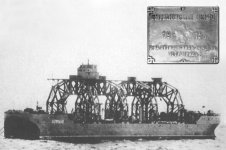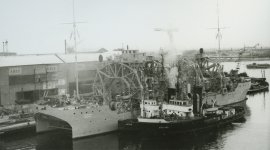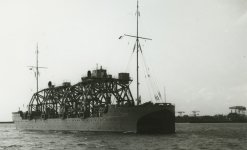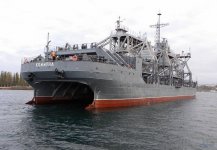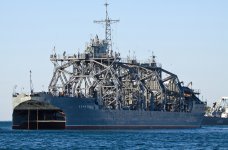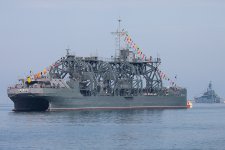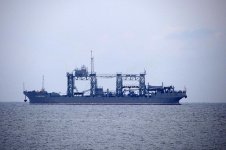As a testament to the levels of quality equipment which was mass produced in the past, I wanted to present to you this Russian submarine salvage ship Kommuna. Christened Volkhov in 1912, it was renamed in 1922 and ever since has been known as Kommuna. On November 17th, 2013 this ship celebrated 100 full years serving the needs of the Russian, Soviet Union, and, once again, Russian Navy.
Kommuna is a submarine salvage ship in service with the Russian Navy's Black Sea Fleet. A double-hulled catamaran, she was laid down at the Putilov Factory in St. Petersburg in November 1912 as Volkhov. The ship was launched the following year, and commissioned on 14 July 1915. She was renamed Kommuna on 31 December 1922. Having served in the Russian Imperial, Soviet, and Russian Federation navies through the Russian Revolution and two World Wars, she is the oldest ship still in service with any navy (excluding such honorary commissioned ships as USS Constitution and HMS Victory).
The mystery of this ship's longevity is hidden within the steel used to produce its hull. The hull simply refuses to rust, and after over 100 years of service displays exactly ZERO signs of corrosion. The steel was developed at the iron works factories which used to belong to Nikolay Putilov.
Nikolay Ivanovich Putilov was a Russian engineer, Industrialist and founder of the Putilov Company (now the Kirov Plant). He was one of Russia's greatest metallurgists and one of the greatest figures of early Russian Industry.

1820-1880
The desire of the Russian scientists, and authorities to solve the puzzle presented by this Putilov's steel appears to be high enough. To unravel the mystery of the ship's hull, they hired one of the top Russian labs called "Composite".

Allegedly, after 100+ years of service with regular maintenance conducted, a piece of the original rudder which was tested for corrosion came back with no signs of it. The same steel was used for the entire hull of the ship. There were multiple additional pieces of equipment installed on the ship during its years of service. Most of them had to be eventually replaced because of the natural instances of corrosion caused by the marine conditions. As you probably guessed by now, the original parts have never required any replacements blamed on the corrosion of the Putilov's steel.
KD: Today, in 2018, with all the sophisticated computerized equipment, we are unable to figure out a 100 year old cooking recipe used to produce steel in 1912. How is it possible? Probably because we lost the technology again. But how can you loose something you've never had? Looks like once again, it was somebody else's technology and we just scored some pre-made sheets of metal. Judging by the multitude of the rivets peppering the hull of the ship, it was indeed built by the reported individuals. But then again... may be it was not. Go figure now.
Titanic, Olympic, Britannic, Great Eastern, Ironclads... they are all gone. Kommuna is here for us to marvel. It appears there is nothing tremendously special in this 100 year old ship besides her age, and her steel. Yet, this age, and this steel speak volumes of the technical abilities of the recent past.
Kommuna is a submarine salvage ship in service with the Russian Navy's Black Sea Fleet. A double-hulled catamaran, she was laid down at the Putilov Factory in St. Petersburg in November 1912 as Volkhov. The ship was launched the following year, and commissioned on 14 July 1915. She was renamed Kommuna on 31 December 1922. Having served in the Russian Imperial, Soviet, and Russian Federation navies through the Russian Revolution and two World Wars, she is the oldest ship still in service with any navy (excluding such honorary commissioned ships as USS Constitution and HMS Victory).
The mystery of this ship's longevity is hidden within the steel used to produce its hull. The hull simply refuses to rust, and after over 100 years of service displays exactly ZERO signs of corrosion. The steel was developed at the iron works factories which used to belong to Nikolay Putilov.
Nikolay Ivanovich Putilov was a Russian engineer, Industrialist and founder of the Putilov Company (now the Kirov Plant). He was one of Russia's greatest metallurgists and one of the greatest figures of early Russian Industry.
1820-1880
Allegedly, after 100+ years of service with regular maintenance conducted, a piece of the original rudder which was tested for corrosion came back with no signs of it. The same steel was used for the entire hull of the ship. There were multiple additional pieces of equipment installed on the ship during its years of service. Most of them had to be eventually replaced because of the natural instances of corrosion caused by the marine conditions. As you probably guessed by now, the original parts have never required any replacements blamed on the corrosion of the Putilov's steel.
Kommuna's History
- Volkhov made her first successful salvage of a submarine in the summer of 1917, raising the American Holland (Holland)-class submarine AG 15.
- On 24 September 1917, Volkhov refloated the Bars-class submarine Edinorog from a depth of 13.5 metres (44 ft).
- From late 1917 Volkhov participated in the Russian Civil War, serving the submarines of the Soviet Baltic Fleet, and on 31 December 1922 she was renamed Kommuna.
- Following the German invasion in June 1941 Kommuna was based at Leningrad, and although damaged by bombing continued to serve throughout the siege. In March 1942 she recovered four KV tanks, two tractors and 31 vehicles from Lake Ladoga, which had fallen through the ice road, called the "Road of Life", which was Leningrad's only supply route. That year she also repaired six M-class submarines, as well as salvaging the Shchuka class 411, the tugboat Austra, the schooners Trud and Vodoley-2, and several other vessels. In February 1943, the crew of Kommuna were sent to the Volga where they recovered the tug Ivan and an Ilyushin Il-2 aircraft. In 1944, Kommuna recovered 14 wrecks, totalling 11,767 tons, and repaired 34 ships. Following the end of the siege the entire crew were awarded the Medal "For the Defence of Leningrad". The ship continued to serve after the war, and in 1954 she was refitted and her engines were replaced by more modern Dutch ones. In November 1956 she located the submarine M-200, and in October 1957 raised the M-256.
- In 1967, the ship sailed from the Baltic to the Black Sea, and was refitted at a cost of 11 million rubles to carry submersibles. In 1974 she was equipped with a Type AS-6 Poisk-2 submersible, which on 15 December 1974 made a record dive to a depth of 2,026 metres (6,647 ft). In 1977 it was used in the search for a Sukhoi Su-24 aircraft that crashed and sank off the Caucasus at a depth of 1,700 metres (5,600 ft).
- In 1984 the ship was laid up for transfer to the Russian Academy of Sciences. However, the transfer was cancelled, and she was thoroughly looted, and had to be completely refitted before returning to Naval service. In 1999 she was re-designated from "salvage ship" to "rescue ship"
- In October 2009 she received a British-built submarine rescue submersible Pantera Plus, capable of operating to depths of up to 1,000 metres (3,300 ft). As of January 2012 she forms part of the detachment of rescue vessels based at Sevastopol.
- Russian salvage ship Kommuna
- Google Translate
- Putilov Iron Works
- Why A Czarist Warship Remains In Service
KD: Today, in 2018, with all the sophisticated computerized equipment, we are unable to figure out a 100 year old cooking recipe used to produce steel in 1912. How is it possible? Probably because we lost the technology again. But how can you loose something you've never had? Looks like once again, it was somebody else's technology and we just scored some pre-made sheets of metal. Judging by the multitude of the rivets peppering the hull of the ship, it was indeed built by the reported individuals. But then again... may be it was not. Go figure now.
Titanic, Olympic, Britannic, Great Eastern, Ironclads... they are all gone. Kommuna is here for us to marvel. It appears there is nothing tremendously special in this 100 year old ship besides her age, and her steel. Yet, this age, and this steel speak volumes of the technical abilities of the recent past.


